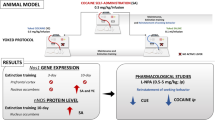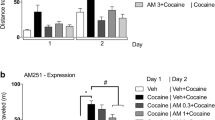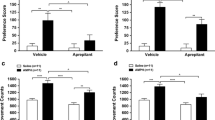Abstract
Rationale
There is evidence that central mu opioid receptors (MORs) are implicated in several aspects of cocaine addiction, and that MOR expression is elevated by cocaine in vitro and in the nucleus accumbens (NAc) when administered in vivo.
Objective
To understand the cellular mechanisms involved in regulating MOR expression, this study explored whether neuronal nitric oxide synthase (nNOS) modulates the neurochemical and behavioral effects of acute and repeated cocaine administration.
Methods
Male Sprague-Dawley rats received a single cocaine injection (20 mg/kg, i.p.) in combination with the selective nNOS inhibitor 7-nitroindazole (7-NI) (0, 25, or 50 mg/kg, i.p.), and the expression of MOR and nNOS messenger RNA (mRNA) and protein levels in the NAc were measured. In a separate conditioned place preference (CPP) experiment, 7-NI (0, 25, or 50 mg/kg, i.p.) was administered prior to cocaine (0 or 20 mg/kg, i.p.) conditioning sessions, and levels of MOR and nNOS mRNA and protein in the NAc were measured following CPP test.
Results
Acute cocaine administration significantly enhanced nNOS and MOR mRNA and protein expression in the NAc, and this increase in MOR expression was blocked by 7-NI. Furthermore, in 7-NI pre-treated rats, cocaine-induced CPP was not statistically significant and the increase in MOR mRNA expression in the NAc in these animals was attenuated.
Conclusions
These findings suggest that nNOS modulates MOR expression following acute cocaine administration, and that cocaine CPP and associated upregulation of MOR expression involve both nNOS-dependent and independent mechanisms. Elucidation of these molecular events may identify useful therapeutic target for cocaine addiction.




Similar content being viewed by others
References
Azaryan AV, Clock BJ, Cox BM (1996a) Mu opioid receptor mRNA in nucleus accumbens is elevated following dopamine receptor activation. Neurochem Res 21:1411–1415
Azaryan AV, Clock BJ, Rosenberger JG, Cox BM (1998) Transient upregulation of mu opioid receptor mRNA levels in nucleus accumbens during chronic cocaine administration. Can J Physiol Pharmacol 283:1–6
Azaryan AV, Coughlin LJ, Búzás B, Clock BJ, Cox BM (1996b) Effect of chronic cocaine treatment on mu- and delta-opioid receptor mRNA levels in dopaminergically innervated brain regions. J Neurochem 66:443–448
Badanich K, Adler K, Kirstein C (2006) Adolescents differ from adults in cocaine conditioned place preference and cocaine-induced dopamine in the nucleus accumbens septi. Eur J Pharmacol 550:95–106
Bailey A, Yoo JH, Racz I, Zimmer A, Kitchen I (2007) Preprodynorphin mediates locomotion and D2 dopamine and μ-opioid receptor changes induced by chronic “binge” cocaine administration. J Neurochem 102:1817–1830
Bailey A, Yuferov V, Bendor J, Schlussman SD, Zhou Y, Ho A, Kreek MJ (2005) Immediate withdrawal from chronic “binge” cocaine administration increases μ-opioid receptor mRNA levels in rat frontal cortex. Mol Brain Res 137:258–262
Balda M, Anderson K, Itzhak I (2006) Adolescent and adult responsiveness to the incentive value of cocaine reward in mice: role of the neuronal nitric oxide synthase (nNOS) gene. Neuropharmacology 51:341–349
Bibb JA, Chen J, Taylor JR, Svenningsson P, Nishi A, Snyder GL, Yan Z, Sagawa ZK, Ouimet CC, Nairn AC, Nestler EJ, Greengard P (2001) Effects of chronic exposure to cocaine are regulated by the neural protein Cdk5. Nature 410:376–380
Bilsky EJ, Montegut MJ, Delong CL, Reid LD (1992) Opioidergic modulation of cocaine conditioned place preferences. Life Sci 50:L85–L90
Boudreau AC, Reimers JM, Milovanovic M, Wolf ME (2007) Cell surface AMPA receptors in the rat nucleus accumbens increase during cocaine withdrawal but internalize after cocaine challenge in assocaition with altered activation of miotgen-activated protein kinases. J Neurosci 27:10621–10635
Bradford MM (1976) A rapid and sensitive method for the quantitation of microgram quantities of protein utilizing the principle of protein-dye binding. Anal Biochem 72:248–254
Cheng X, Luo H, Hou Z, Huang YAN, Sun J, Zhou L (2014) Neuronal nitric oxide synthase, as a downstream signaling molecule of c-Jun, regulates the survival of differentiated PC12 cells. Mold Med Rep 10(4):1881–1886
Corrigall WA, Coen KM (1991) Opiate antagonists reduce cocaine but not nicotine self-administration. Psychopharmacology 104:167–170
Demas GE, Eliasson MJ, Dawson TM, Dawson VL, Kriegsfeld LJ, Nelson RJ, Snyder SH (1997) Inhibition of neuronal nitric oxide synthase increases aggressive behavior in mice. Mol Med 3:610–616
Gerrits MA, Patkina N, Zvartau EE, Van Ree JM (1995) Opioid blockade attenuates acquisition and expression of cocaine-induced place preference conditioning in rats. Psychopharmacology 119:92–98
Ghitza UE, Preston KL, Epstein DH, Kuwabara H, Endres CJ, Bencherif B, Boyd SJ, Copersino ML, Frost JJ, Gorelick DA (2010) Brain mu-opioid receptor binding predicts treatment outcome in cocaine-abusing outpatients. Biol Psychiatry 68:697–703
Gorelick DA, Kim YK, Bencherif B, Boyd SJ, Nelson R, Copersino M, Endres CJ, Dannals RF, Frost JJ (2005) Imaging brain mu-opioid receptors in abstinent cocaine users: time course and relation to cocaine craving. Biol Psychiatry 57:1573–1582
Hammer RP (1989) Cocaine alters opiate receptor binding in critical brain reward regions. Synapse 3:55–60
Houdi AA, Bardo MT, Van Loon GR (1989) Opioid mediation of cocaine-induced hyperactivity and reinforcement. Brain Res 497:195–198
Hummel M, Schroeder J, Liu-Chen LY, Cowan A, Unterwald EM (2006) An antisense oligodeoxynucleotide to the mu opioid receptor attenuates cocaine-induced behavioral sensitization and reward in mice. Neuroscience 142:481–491
Itzhak Y (1996) Attenuation of cocaine kindling by 7-nitroindazole, an inhibitor of brain nitric oxide synthase. Neuropharmacology 35:1065–1073
Itzhak Y (2008) Role of the NMDA receptor and nitric oxide in memory reconsolidation of cocaine-induced conditioned place preference in mice. Ann N Y Acad Sci 1139:350–357
Itzhak Y, Ali SF, Martin JL, Black MD, Huang PL (1998) Resistance of neuronal nitric oxide synthase-deficient mice to cocaine- induced locomotor sensitization. Psychopharmacology 140:378–386
Itzhak Y, Anderson KL (2007) Memory reconsolidation of cocaine-associated context requires nitric oxide signaling. Synapse 61:790–794
Kalisch BE, Connop BP, Jhamandas K, Beninger RJ, Boegman RJ (1996) Differential action of 7-nitro indazole on rat brain nitric oxide synthase. Neurosci Lett 219:75–78
Kim HS, Park WK (1995) Nitric oxide mediation of cocaine-induced dopaminergic behaviors: ambulation-accelerating activity, reverse tolerance and conditioned place preference in mice. J Pharmacol Exp Ther 275:551–557
Kim HS, Park WK, Jang CG, Oh KW, Kong JY, Oh S, Rheu HM, Cho DH, Kang SY (1997) Blockade by naloxone of cocaine-induced hyperactivity, reverse tolerance and conditioned place preference in mice. Behav Brain Res 85:37–46
Koh WC, Rahman MA, Choe ES, Lee DK, Shim YB (2008) A cytochrome c modified-conducting polymer microelectrode for monitoring in vivo changes in nitric oxide. Biosens Bioelectron 23:1374–1381
Koob GF, Volkow ND (2009) Neurocircuitry of addiction. Neuropsychopharmacology 35:217–238
Kreek MJ, Levran O, Reed B, Schlussman SD, Zhou Y, Butelman ER (2012) Opiate addiction and cocaine addiction: underlying molecular neurobiology and genetics. J Clin Invest 122:3387–3393
Le Merrer J, Becker JAJ, Befort K, Kieffer BL (2009) Reward processing by the opioid system in the brain. Phys Rev 89:1379–1412
Lee DK, Koh WCA, Shim YB, Shim I, Choe ES (2010) Repeated cocaine administration increases nitric oxide efflux in the rat dorsal striatum. Psychopharmacology 208:245–256
Leri F, Zhou Y, Goddard B (2009) Steady-state methadone blocks cocaine seeking and cocaine- induced gene expression alterations in the rat brain. Eur Neuropsychopharmacol 44:735–745
Leri F, Zhou Y, Goddard B, Cummins E, Kreek MJ (2006) Effects of high-dose methadone maintenance on cocaine place conditioning, cocaine self-administration, and mu-opioid receptor mRNA expression in the rat brain. Neuropsychopharmacology 31:1462–1474
Loftis JM, Janowsky A (2000) Regulation of NMDA receptor subunits and nitric oxide synthase expression during cocaine withdrawal. J Neurochem 75:2040–2050
MacKenzie GM, Rose S, Bland-Ward PA, Moore PK, Jenner P, Marsden CD (1994) Time course of inhibition of brain nitric oxide synthase by 7-nitroindazole. Neuroreport 5:1993–1996
Mattson BJ, Bossert JM, Simmons DE, Nozaki N, Nagarkar D, Kreuter JD, Hope BT (2005) Cocaine-induced CREB phosphorylation in nucleus accumbens of cocaine-sensitized rats is enabled by enhanced activation of extracellular signal-related kiase, but not protein kinase a. J Neurochem 95:1481–1494
Mueller D, Stewart J (2000) Cocaine-induced conditioned place preference: reinstatement by priming injections of cocaine after extinction. Behav Brain Res 115:39–47
Nestler EJ (2005) The neurobiology of cocaine addiction. Sci Pract Perspect 3:4–10
Ng KY, Xue YD, Wong PT (1999) Different distributions of nitric oxide synthase-containing neurons in the mouse and rat hypothalamus. Nitric Oxide 3:383–392
Nygard SK, Klambatsen A, Balouch B, Quinones-Jenab V, Jenab S (2017) NMDAR dependent intracellular responses associated with cocaine conditioned place preference behavior. Behav Brain Res 317:218–225
Pudiak CM, Bozarth MA (2002) The effect of nitric oxide synthesis inhibition on intravenous cocaine self-administration. Prog Neuro-Psychopharmacol Biol Psychiatry 26:189–196
Pudiak CM, Bozarth MA (2013) Effect of post-trial L-NAME administration on cocaine sensitization. Int J Neurosci 123:663–669
Ramsey NF, Gerrits MA, Van Ree JM (1999) Naltrexone affects cocaine self- administration in naive rats through the ventral tegmental area rather than dopaminergic target regions. Eur Neuropsychopharmacol 9:93–99
Sammut S, West AR (2008) Acute cocaine administration increases NO efflux in the rat prefrontal cortex via a neuronal NOS-dependent mechanism. Synapse 62:710–713
Schramm-Saptya N, Walker D, Caster J, Levin E, Kuhn C (2009) Are adolescents more vunerable to drug addictions than adults? Evidence from animals models. Psychopharmacology 206:1–21
Schroeder JA, Niculescu M, Unterwald EM (2003) Cocaine alters mu but not delta or kappa opioid receptor-stimulated in situ [35S]GTPS binding in rat brain. Synapse 47:26–32
Seiwell AP, Reveron ME, Duvauchelle CL (2007) Increased accumbens Cdk5 expression in rats after short-access to selfadministered cocaine, but not after long-access sessions. Neurosci Lett 417:100–105
Simoes AES, Pereira DM, Amaral JD, Nunes AF, Gomes SE, Rodrigues PM (2013) Efficient recovery of proteins from multiple source samples after trizol or trizol LS RNA extraction and long-term storage. BMC Genomics 14:1471–2164
Soderman AR, Unterwald EM (2009) Cocaine-induced mu opioid receptor occupancy within the striatum is mediated by dopamine D2 receptors. Brain Res 1296:63–71
Steketee JD, Rowe LA, Chandler LJ (1998) The effects of acute and repeated cocaine injections on protein kinase C activity and isoform levels in dopaminergic brain regions. Neuropharmacology 37:339–347
Sticht M, Mitsubata J, Tucci M, Leri F (2010) Reacquisition of heroin and cocaine place preference involves a memory consolidation process sensitive to systemic and intra-ventral tegmental area naloxone. Neurobiol Learn Mem 93:248–260
Suzuki T, Shiozaki Y, Masukawa Y, Misawa M, Nagase H (1992) The role of mu- and kappa-opioid receptors in cocaine-induced conditioned place preference. Jpn J Pharmacol 58:435–442
Tian Y, Lee K, You I, Lee S, Jang C (2008) 7-Nitroindazole, nitric oxide synthase inhibitor attenuates physical dependence on butorphanol in eat. Synapse 589:582–589
Tricoire L, Vitalis T (2012) Neuronal nitric oxide synthase expressing neurons: a journey from birth to neuronal circuits. Front Neural Circuits 6:82
Unterwald EM, Horne-King J, Kreek MJ (1992) Chronic cocaine alters brain mu opioid receptors. Brain Res 584:314–318
Unterwald EM, Kreek MJ, Cuntapay M (2001) The frequency of cocaine administration impacts cocaine-induced receptor alterations. Brain Res 900:103–109
Unterwald EM, Rubenfeld JM, Kreek MJ (1994) Repeated cocaine administration upregulates kappa and mu, but not delta, opioid receptors. Neuroreport 5:1613–1616
Vitcheva V, Simeonova R, Kondeva-Burdina M, Mitcheva M (2015) Selective nitric oxide synthase inhibitor 7-Nitroindazole protects against cocaine-induced oxidative stress in rat brain. Oxidative Med Cell Longev 2015:1–8
Vogel C, Marcotte EM (2012) Insights into the regulation of protein abundance from proteomic and transcriptomic analyses. Nat Rev Genet 13:227–232
Winick-Ng W, Leri F, Kalisch BE (2012) Nitric oxide and histone deacetylases modulate cocaine-induced mu-opioid receptor levels in PC12 cells. BMC Pharmacol Toxicol 13:11–22
Yoo J, Cho J, Lee S, Lee S, Loh HH, Ho IK, Jang C (2006) Differential effects of morphine- and cocaine-induced nNOS immunoreactivity in the dentate gyrus of hippocampus of mice lacking mu-opioid receptors. Neurosci Lett 395:98–102
Zakharova E, Leoni G, Kichko I, Izenwasser S (2009) Differential effects of methamphetamine and cocaine on conditioned place preference and locomotor activity in adult and adolescent male rats. Behav Brain Res 198:45–50
Zhou Z, Enoch M-A, Goldman D (2014) Gene expression in the addicted brain. Int Rev Neurobiol 116:251–273
Zubieta JK, Gorelick DA, Stauffer R, Ravert HT, Dannals RF, Frost JJ (1996) Increased mu opioid receptor binding detected by PET in cocaine-dependent men is associated with cocaine craving. Nat Med 2:1225–1229
Funding
Funding was provided by the Natural Sciences and Engineering Research Council of Canada (FL), Canadian Institutes of Health Research, Ontario Veterinary College.
Author information
Authors and Affiliations
Corresponding author
Ethics declarations
Conflict of interest
The authors declare that they have no conflict of interest.
Rights and permissions
About this article
Cite this article
Thériault, RK., Leri, F. & Kalisch, B. The role of neuronal nitric oxide synthase in cocaine place preference and mu opioid receptor expression in the nucleus accumbens. Psychopharmacology 235, 2675–2685 (2018). https://doi.org/10.1007/s00213-018-4961-1
Received:
Accepted:
Published:
Issue Date:
DOI: https://doi.org/10.1007/s00213-018-4961-1




